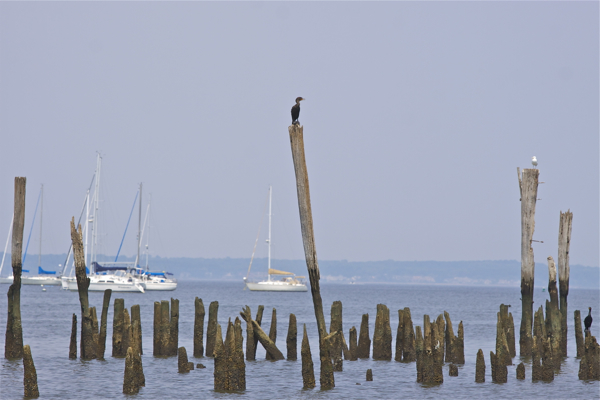
Raritan Bay
Real Solutions Require Money, Regulation, Development Controls, and Enforcement
[Update: 6/24/12 – the stenographers in the NJ press corps never seem to tire of this crap. Here’s another, also with a cop beat (and hint of the Bayway refinery is horrible headline to boot):
DEP patrols waters for bayway violators – end]
On Wednesday (October 19), DEP will “spearhead” a “Barnegat Bay Blitz”.
OOOH I just love it when you talk military to me baby!
Sounds important, eh?
But don’t get your hopes up, it’s only a litter cleanup day.
According to another DEP press release flogging the PR monkey for Governor Christie:
This hands-on effort demonstrates the Christie Administration’s continued commitment to restoring Barnegat Bay, which for decades has been subject to increasing ecological stress, much of it related to stormwater pollution. The cleanup will enable local residents and groups to become directly engaged in the Governor’s 10-point comprehensive restoration plan for the bay, which the Governor launched in December 2010.
Perhaps the timing of this event has something to do with Sunday’s critical Star Ledger editorial “NJ must do more to protect Barnegat Bay” which found Governor’s Christie’s plan woefully deficient:
The governor hasn’t faced the fact that this job will be expensive. He is trying to do a cleanup on the cheap. And he’s even blocked the county government from taking helpful steps.
Containing stormwater runoff is a critical part of this effort. But Christie’s plan calls for spending $16 million for upgrades now, and offers up to $100 million in loans over the next decade for towns that want to repair their stormwater systems. At that pace, the job wouldn’t be done for nearly two decades, while damage to the bay continues.
He killed a bill that would have allowed Ocean County to place a fee on developers who are the biggest polluters. This should have been the county’s call. The legislation would only have provided the option. He killed another bill that would have charged a similar fee of households. Either would have guaranteed ongoing funding to pay for pollution fixes.
He also conditionally vetoed a bill that would have set a legal standard for how much overall pollution is allowed in the bay, based on what’s necessary to restore it back to health.
Christie still hasn’t wrestled with limits on development in the Barnegat Bay area, which is the root of this problem. A full moratorium is probably not realistic, but some limits are vital. Much of that work must be done at the local level, with support from the state for purchase of open space.
Believe me, the Ledger editorial offered unwarranted praise and was being gentle with its criticism of the Governor here.
And we’re sure that when the Star Ledger called for the Governor to “do more“, they weren’t talking about litter pickups.
Which brings us to one interesting substantive issue buried in the DEP press release.
DEP inadvertently acknowledged an important point, which provides an opportunity to contrast DEP’s very different responses to statewide problems that share a common cause.
Specifically, DEP acknowledged that trash enters waterways, becoming water pollution known as “floatables”, via the same antiquated storm water systems that carry raw sewage (combined sewer overflows) and storm water pollution:
Much of the trash that will be collected on Wednesday could otherwise ultimately enter the bay through the discharge of stormwater. Stormwater also carries other pollutants such as common lawn fertilizers, automotive fluids and silt that degrade wildlife habitat and water quality in Barnegat Bay and its tributaries.
As we’ve long written here, NJ’s storm water infrastructure is seriously deficient, in need of billions of dollars of investment – a glaring need that has long been ignored.
Finally coming around to this issue, on September 25, 2011, the Star Ledger reported that “EPA: NJ needs $8 billion to fix antiquated sewer systems”
At more than 200 spots like this in New Jersey, outdated sewer systems pour more than 23 billion gallons of raw sewage into the water each year, according to the U.S. Environmental Protection Agency.
And residents — including those who boat, kayak and fish these waterways — are usually never told when the sewage is flowing, officials say.
It doesn’t take a hurricane for the sewers to surge. Even small rainfalls can cause a dirty cocktail of bacteria to spew from 224 nondescript pipes that are mostly in northern New Jersey, EPA says, posing a serious health risk to anyone who touches the water.
Frustrated by the state’s lack of progress, the federal agency is pressuring the Christie administration to fix the long-standing problem, which EPA estimates could cost more than $8 billion.
Both the garbage (floatables) and the raw sewage and other pollution are carried by the same deficient storm water systems.
Both EPA and DEP require controls on the floatables, but do little to correct the CSO raw sewage and other pollutants.
For example, there are EPA approved DEP “floatables action plans” plans for NY Harbor Complex and Raritan Bay.
But CSO permit requirements are weak and outdated CSO control plans are shelved and unfunded.
So, let’s compare the DEP’s litter/floatables response with the tougher and far more important problem of CSO and stormwater controls.
- Litter pickups are cheap, voluntary, and ruffle no feathers in the business community.
- Litter pickups provide great press, but have little impact and thus create a false appearance of environmental initiative.
In contrast, CSO and storm water pollution controls are exactly the opposite:
- they cost real money,
- are imposed via regulation,
- aggravate business, and
- make real progress on improving environmental quality.
Which is exactly why the Christie Administration ignores them and pulls PR stunts like the “Barnegat Bay Blitz”.

Pingback: WolfeNotes.com » Another Friday Afternoon Shakeup in DEP Management
Pingback: WolfeNotes.com » DEP’s Systematic Failure to Enforce Stormwater Controls Leads to Breakdown of Entire Clean Water Program
Pingback: WolfeNotes.com » Gov. Christie Forgot All About Barnegat Bay In Sandy Rush To Rebuild